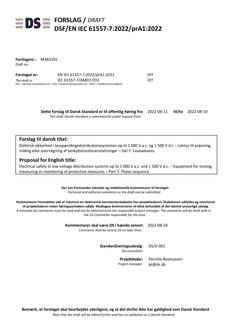-
-
Available Formats
- Availability
- Priced From ( in USD )
-
Available Formats
-
- Immediate download
-
$59.00Members pay $44.25
- Add to Cart
-
- Printed Edition
- Ships in 1-2 business days
-
$59.00Members pay $44.25
- Add to Cart
Customers Who Bought This Also Bought
-

DANSK DS/ISO 14839-1
Priced From $75.00 -

DANSK DSF/EN IEC 61557-7/PRA1
Priced From $25.00 -

DANSK DSF/PREN IEC 60034-2-1
Priced From $69.00 -

DANSK DSF/EN ISO 10462/PRA1
Priced From $25.00
About This Item
Full Description
This International Standard defines the design, safety and operation characteristics of gaseous hydrogen land vehicle (GHLV) refuelling connectors. GHLV refuelling connectors consist of the following components, as applicable: – receptacle and protective cap (mounted on vehicle); – nozzle; – communication hardware, if applicable. This International Standard applies to refuelling connectors which have working pressures of 11 MPa, 25 MPa, 35 MPa and 70 MPa, hereinafter referred to in this International Standard as the following: – H11 – 11 MPa at 15 °C; – H25 – 25 MPa at 15 °C; – H35 – 35 MPa at 15 °C; – H35HF – 35 MPa at 15 °C (high flow for commercial vehicle applications); – H70 – 70 MPa at 15 °C. Nozzles and receptacles that meet the requirements of this International Standard will only allow GHLVs to be filled by fuelling stations dispensing hydrogen with nominal working pressures equal to or lower than the vehicle fuel system working pressure. They will not allow GHLV to be filled by fuelling stations dispensing blends of hydrogen with natural gas. Nozzles and receptacles defined in this International Standard can be used to fuel different types of GHLVs. The refuelling stations for these vehicles may have significantly different process limits and refuelling protocols. The nozzle and receptacle alone may not ensure that a GHLV cannot refuel at an incompatible station. If this occurs, the GHLV may be exposed to conditions outside of its intended limits, such as fuel container overheating. If this is a potential problem, the user and station manufacturer should develop additional controls to mitigate this risk. As stated in ECE/TRANS/180/Add. 13 Global Technical Regulation No. 13 (Global technical regulation on hydrogen and fuel cell vehicles – 19 July 2013), “Assurance of capability to sustain multiple occurrences of over-pressurization due to fuelling station failure is provided by the requirement to demonstrate absence of leak in 10 exposures to 150 per cent NWP fuelling.” Nozzles and receptacles defined in this International Standard shall be tested in this way to accommodate similar fuelling station over-pressurization occurrences. Nozzles that have been subjected to 10 over-pressurization occurrences shall be removed from service.





